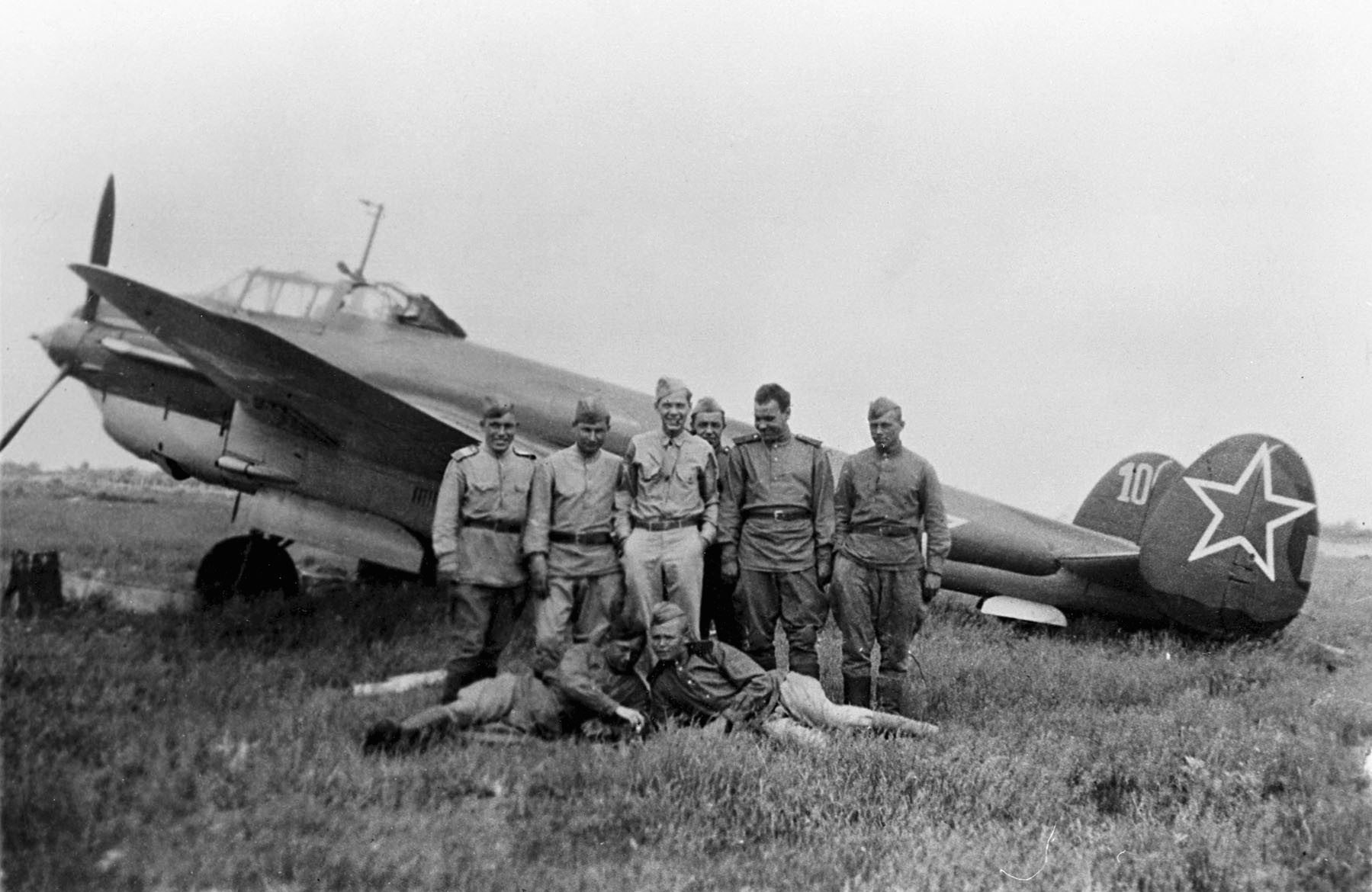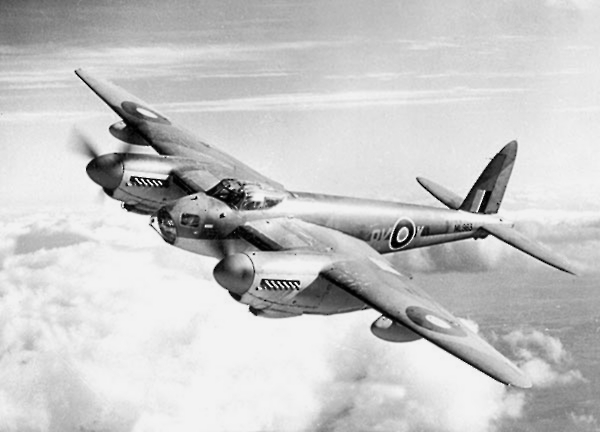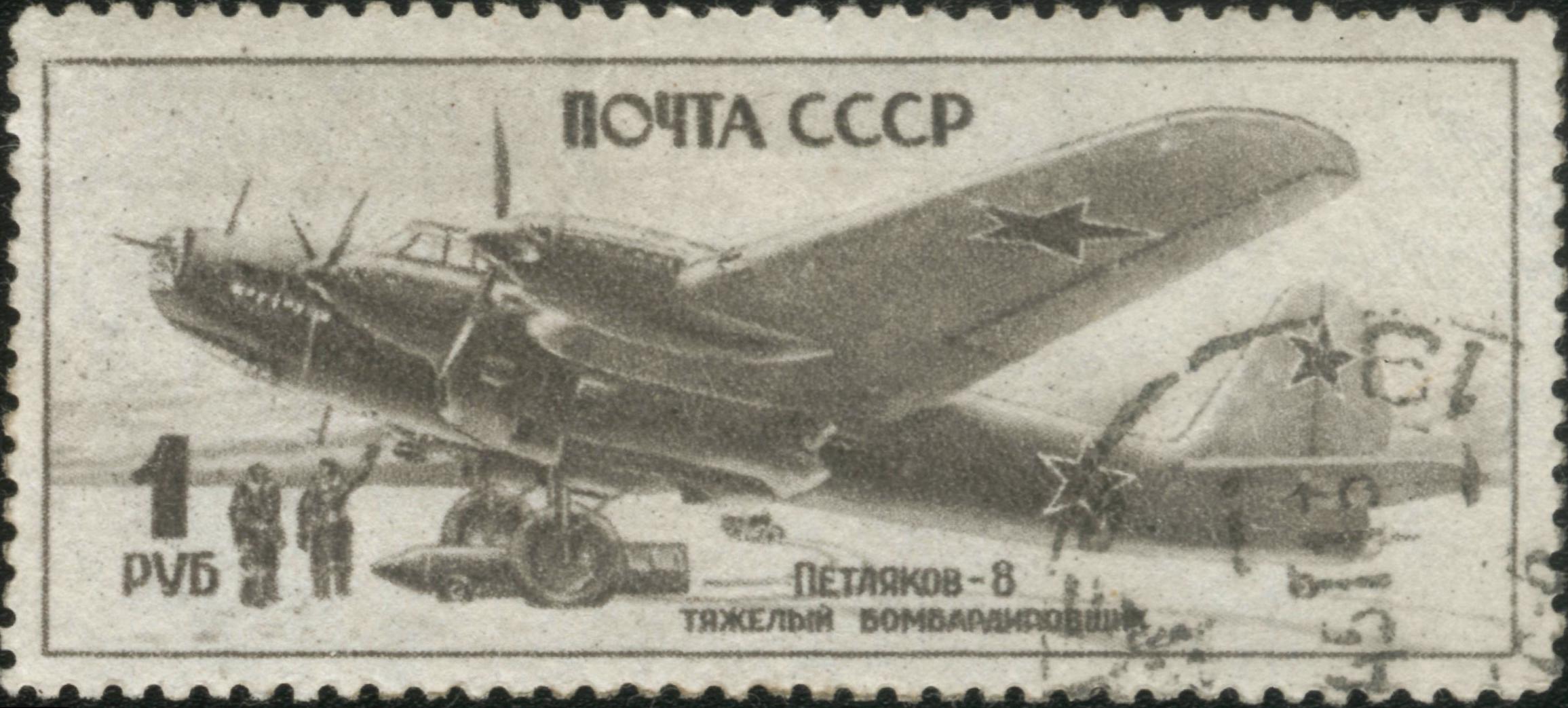|
Pe-2
The Petlyakov Pe-2 (russian: Петляков Пе-2) was a Soviet Union, Soviet twin-engine dive bomber used during World War II. One of the outstanding tactical attack aircraft of the war,Ethell 1996, p. 152. it also proved successful as a heavy fighter, as a night fighter (Petlyakov Pe-3, Pe-3 variant) and as a reconnaissance aircraft.Angelucci and Matricardi 1978, p. 234. The Pe-2 was, numerically, the most important Soviet bomber of World War II, at their peak comprising 75% of the Soviet twin-engine bomber force.Smith 2003, pp. 155. The Soviets manufactured Pe-2s in greater numbers (11,430 built) during the war than any other twin-engine combat aircraft except for the German Junkers Ju 88 and the British Vickers Wellington.Guston 1980, p. 173. Several communist air forces flew the type after the war, when it became known by the NATO reporting name ''Buck''. Development In 1937, Vladimir Petlyakov was the leader of the Heavy Aircraft Brigade at the Tupolev OKB responsible for ... [...More Info...] [...Related Items...] OR: [Wikipedia] [Google] [Baidu] |
Vladimir Mikhailovich Myasishchev
Vladimir Mikhailovich Myasishchev (russian: Владимир Михайлович Мясищев) (September 28, 1902 in Yefremov (town), Yefremov – October 14, 1978 in Moscow) was a Soviet Union, Soviet aircraft designer, Major General of Engineering (1944), Hero of Socialist Labor (1957), Doctor of Technical Sciences (1959), Honoured Scientist of the RSFSR (1972). After his graduation from Moscow State Technical University in 1926, Myasishchev worked at the Tupolev Design Bureau and took part in constructing airplanes, such as Tupolev TB-1, Tupolev TB-3, and Tupolev ANT-20 Maxim Gorky. As an assistant to Boris Pavlovich Lisunov, he traveled to the United States in 1937 to help translate the Douglas DC-3 drawings in preparation for the production of the Lisunov Li-2.Gunston, Bill, ''The Encyclopedia of Russian Aircraft 1875–1995'', Motorbooks International 1995. . In 1938, Myasishchev became a victim of a repression campaign. While in confinement, he worked at NKVD's Centra ... [...More Info...] [...Related Items...] OR: [Wikipedia] [Google] [Baidu] |
Petlyakov
V.M. Petlyakov Design Bureau (, ''Opytnoe Konstructorskoe Byuro Petlyakova'') was a Soviet OKB (design bureau) for military aircraft, headed by designer Vladimir Petlyakov. Following his death in 1942, the bureau was controlled by Izakson, Putliov, and Myasishchyev before being dissolved in 1946. Developments * Pe-2 'Buck'/PB-100, 1939. ** VI-100/"100" prototype, "high altitude fighter", 1939. ** Pe-2I fighter ** Pe-3 multirole fighter, 207 were built, 1941. *** Pe-3bis multirole fighter, about 300 were built, 1941. ** Pe-4 Pe-2 with Klimov VK-105PF engines. **Vb-109 (by V.Myasichev) high-altitude bomber. *Pe-8 The Petlyakov Pe-8 (russian: Петляков Пе-8) was a Soviet Union, Soviet heavy bomber designed before World War II, and the only four-engine bomber the USSR built during the war. Produced in limited numbers, it was used to Bombing of Berl .../TB-7 The only four-engined bomber the USSR used during World War II, 1935. References Aircraft manufacturers of the So ... [...More Info...] [...Related Items...] OR: [Wikipedia] [Google] [Baidu] |
Petlyakov Pe-3
The Petlyakov Pe-3 was the long-range heavy fighter version of the successful Petlyakov Pe-2 high-speed dive bomber used by the Soviet Union during World War II. Its design and use followed a comparable path to those taken by the German Luftwaffe with the Junkers Ju 88 and the British Royal Air Force with the De Havilland Mosquito. The Soviets realized the need for a night fighter after the first night bombing of Moscow during Operation Barbarossa. The Petlyakov Pe-2 was selected for modification as the most suitable aircraft available. It was initially used for daylight ground attack missions during the Battle of Moscow, but this proved to be costly since the aircraft was unarmored. Armor and additional guns were retrofitted to the existing aircraft to make it more effective, but the evacuation of the sole factory building the Pe-3 in October 1941 limited the number of aircraft available and many units of the Soviet Air Forces flying the Pe-3 were either disbanded or converted ... [...More Info...] [...Related Items...] OR: [Wikipedia] [Google] [Baidu] |
Heavy Fighter
A heavy fighter is a historic category of fighter aircraft produced in the 1930s and 1940s, designed to carry heavier weapons, and/or operate at longer ranges than light fighter aircraft. To achieve performance, most heavy fighters were twin-engine, and many had multi-place crews; This was in contrast to light fighters, which were typically single-engine and single-crew aircraft. In Germany, they were known as ''Zerstörer'' ("destroyer"). The heavy fighter was a major design class during the pre-World War II period, conceived as long-range escort fighters or heavily-armed bomber destroyers. Most such designs failed in this mission, as they could not maneuver with the more conventional, single-engine fighters, and suffered heavy losses. Most notable among such designs was the Messerschmitt Bf 110, which suffered great losses during the Battle of Britain. An exception was the American Lockheed P-38 Lightning, which proved an effective heavy fighter; even against smaller, lighter, ... [...More Info...] [...Related Items...] OR: [Wikipedia] [Google] [Baidu] |
Vladimir Petlyakov
Vladimir Mikhailovich Petlyakov (russian: Влади́мир Миха́йлович Петляко́в; 15 June 1891 – 12 January 1942) was a Soviet aeronautical engineer and aircraft designer. Petlyakov was born in 1891 in Sambek (Don Host Oblast, Russian Empire) (currently part of Neklinovsky District, Rostov Oblast), where his father served as a local official. After graduating from the Technical College in Taganrog (today the "Taganrog Petlyakov Aviation College", Таганрогский авиационный колледж им. В. М. Петлякова) in 1910. he travelled to Moscow, where he was accepted into the Moscow State Technical University; however, due to financial difficulties he was unable to complete his studies. After the 1917 Russian Revolution he continued his education and was hired to work as a technician in the aerodynamics laboratory at Moscow State Technical University under the guidance of Nikolai Zhukovsky, while resuming his studies. He gai ... [...More Info...] [...Related Items...] OR: [Wikipedia] [Google] [Baidu] |
Junkers Ju 88
The Junkers Ju 88 is a German World War II ''Luftwaffe'' twin-engined multirole combat aircraft. Junkers Aircraft and Motor Works (JFM) designed the plane in the mid-1930s as a so-called ''Schnellbomber'' ("fast bomber") that would be too fast for fighters of its era to intercept. It suffered from technical problems during its development and early operational periods but became one of the most versatile combat aircraft of the war. Like a number of other ''Luftwaffe'' bombers, it served as a bomber, dive bomber, night fighter, torpedo bomber, reconnaissance aircraft, heavy fighter and at the end of the war, as a flying bomb. Despite a protracted development, it became one of the ''Luftwaffe''s most important aircraft. The assembly line ran constantly from 1936 to 1945 and more than 15,000 Ju 88s were built in dozens of variants, more than any other twin-engine German aircraft of the period. Throughout production the basic structure of the aircraft remained unchanged.Angelucci a ... [...More Info...] [...Related Items...] OR: [Wikipedia] [Google] [Baidu] |
Dive Bomber
A dive bomber is a bomber aircraft that dives directly at its targets in order to provide greater accuracy for the bomb it drops. Diving towards the target simplifies the bomb's trajectory and allows the pilot to keep visual contact throughout the bomb run. This allows attacks on point targets and ships, which were difficult to attack with conventional level bombers, even ''en masse''. After World War II, the rise of precision-guided munitions and improved anti-aircraft defences—both fixed gunnery positions and fighter interception—led to a fundamental change in dive bombing. New weapons, such as rockets, allowed for better accuracy from smaller dive angles and from greater distances. They could be fitted to almost any aircraft, including fighters, improving their effectiveness without the inherent vulnerabilities of dive bombers, which needed air superiority to operate effectively. Method A dive bomber dives at a steep angle, normally between 45 and 60 degrees or ev ... [...More Info...] [...Related Items...] OR: [Wikipedia] [Google] [Baidu] |
Czechoslovakian Air Force
The Czechoslovak Air Force (''Československé letectvo'') or the Czechoslovak Army Air Force (''Československé vojenské letectvo'') was the air force branch of the Czechoslovak Army formed in October 1918. The armed forces of Czechoslovakia ceased to exist on 31 December 1992. By the end of the year, all aircraft of the Czechoslovak Air Force were divided between the Czech Air Force and the Slovak Air Force. Organization On 30 October 1918, the establishment of Aviation Corps (''Letecký sbor'') marked the beginning of the Czechoslovak Air Force. Under the First Republic, the air force was an integral service of the Czechoslovak army. During peacetime, the army aviation was a subordinate agency of the Ministry of National Defence within its 3rd Department of Aviation (''III. odbor (letecký) Ministerstva národní obrany'') under the command of divisional general Jaroslav Fajfr (as of October 1938). It was anticipated that individual squadrons and flights would be attached ... [...More Info...] [...Related Items...] OR: [Wikipedia] [Google] [Baidu] |
Soviet Air Force
The Soviet Air Forces ( rus, Военно-воздушные силы, r=Voyenno-vozdushnyye sily, VVS; literally "Military Air Forces") were one of the air forces of the Soviet Union. The other was the Soviet Air Defence Forces. The Air Forces were formed from components of the Imperial Russian Air Service in 1917, and faced their greatest test during World War II. The groups were also involved in the Korean War, and dissolved along with the Soviet Union itself in 1991–92. Former Soviet Air Forces' assets were subsequently divided into several air forces of former Soviet republics, including the new Russian Air Force. "March of the Pilots" was its song. Origins The ''All-Russia Collegium for Direction of the Air Forces of the Old Army'' (translation is uncertain) was formed on 20 December 1917. This was a Bolshevik aerial headquarters initially led by Konstantin Akashev. Along with a general postwar military reorganisation, the collegium was reconstituted as the "Workers' an ... [...More Info...] [...Related Items...] OR: [Wikipedia] [Google] [Baidu] |
Dive Bomber
A dive bomber is a bomber aircraft that dives directly at its targets in order to provide greater accuracy for the bomb it drops. Diving towards the target simplifies the bomb's trajectory and allows the pilot to keep visual contact throughout the bomb run. This allows attacks on point targets and ships, which were difficult to attack with conventional level bombers, even ''en masse''. After World War II, the rise of precision-guided munitions and improved anti-aircraft defences—both fixed gunnery positions and fighter interception—led to a fundamental change in dive bombing. New weapons, such as rockets, allowed for better accuracy from smaller dive angles and from greater distances. They could be fitted to almost any aircraft, including fighters, improving their effectiveness without the inherent vulnerabilities of dive bombers, which needed air superiority to operate effectively. Method A dive bomber dives at a steep angle, normally between 45 and 60 degrees or ev ... [...More Info...] [...Related Items...] OR: [Wikipedia] [Google] [Baidu] |
Petlyakov Pe-8
The Petlyakov Pe-8 (russian: Петляков Пе-8) was a Soviet heavy bomber designed before World War II, and the only four-engine bomber the USSR built during the war. Produced in limited numbers, it was used to bomb Berlin in August 1941. It was also used for so-called "morale raids" designed to raise the spirit of the Soviet people by exposing Axis vulnerabilities. Its primary mission, however, was to attack German airfields, rail yards and other rear-area facilities at night, although one was used to fly the People's Commissar of Foreign Affairs (Foreign Minister) Vyacheslav Molotov from Moscow to the United States in 1942. Originally designated the TB-7, the aircraft was renamed the Pe-8 after its primary designer, Vladimir Petlyakov, died in a plane crash in 1942. Supply problems complicated the aircraft's production and the Pe-8s also had engine problems. As Soviet morale boosters, they were also high-value targets for the Luftwaffe's fighter pilots. The loss rate of t ... [...More Info...] [...Related Items...] OR: [Wikipedia] [Google] [Baidu] |
Polish Air Force
The Polish Air Force ( pl, Siły Powietrzne, , Air Forces) is the aerial warfare branch of the Polish Armed Forces. Until July 2004 it was officially known as ''Wojska Lotnicze i Obrony Powietrznej'' (). In 2014 it consisted of roughly 16,425 military personnel and about 475 aircraft, distributed among ten bases throughout Poland. The Polish Air Force can trace its origins to the second half of 1917 and was officially established in the months following the end of World War I in 1918. During the invasion of Poland by Nazi Germany in 1939, 70% of its aircraft were destroyed. Most pilots, after the Soviet invasion of Poland on September 17, escaped via Romania and Hungary to continue fighting throughout World War II in allied air forces, first in France, then in Britain, and later also the Soviet Union. History Origins Military aviation in Poland started even before the officially recognised date of regaining independence (11 November 1918). The very first independent units of th ... [...More Info...] [...Related Items...] OR: [Wikipedia] [Google] [Baidu] |


.jpg)


